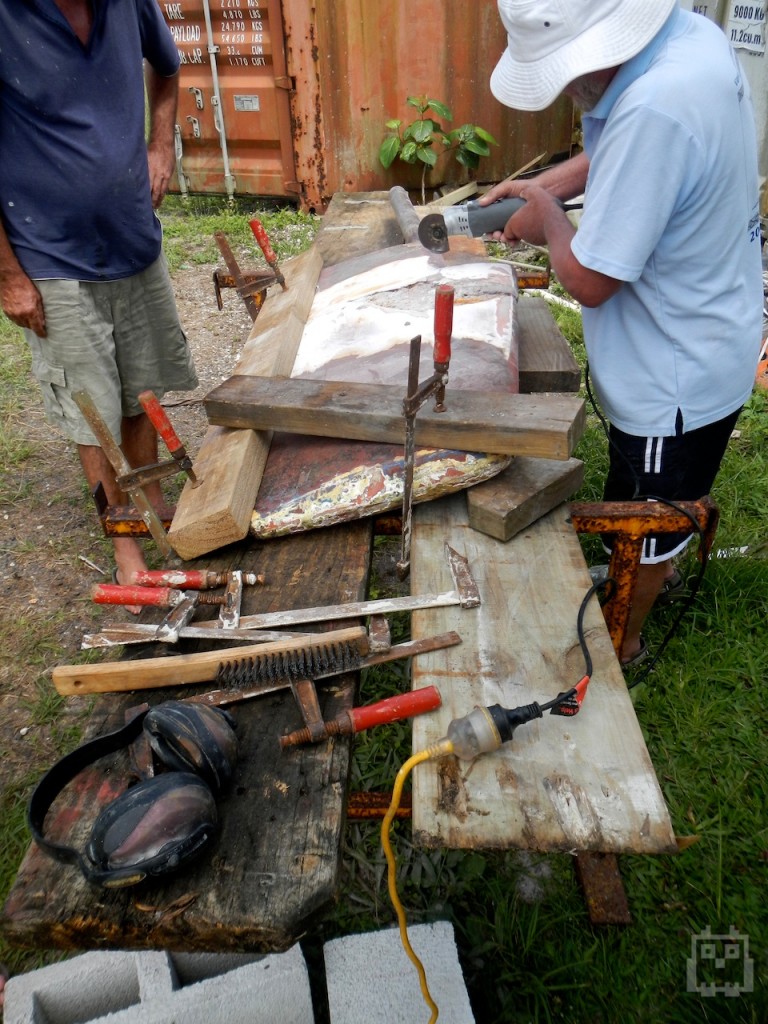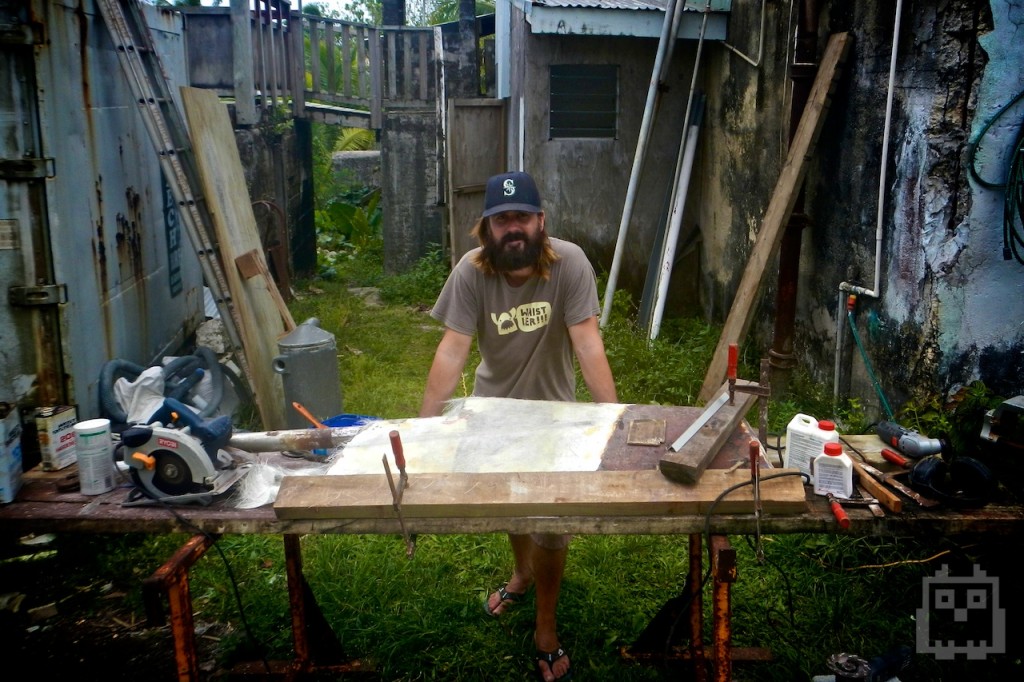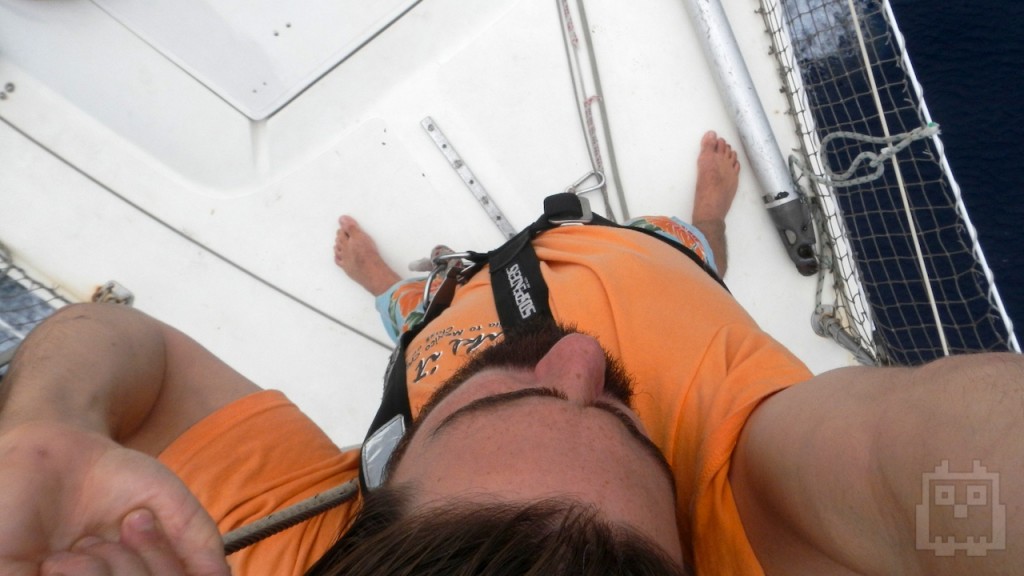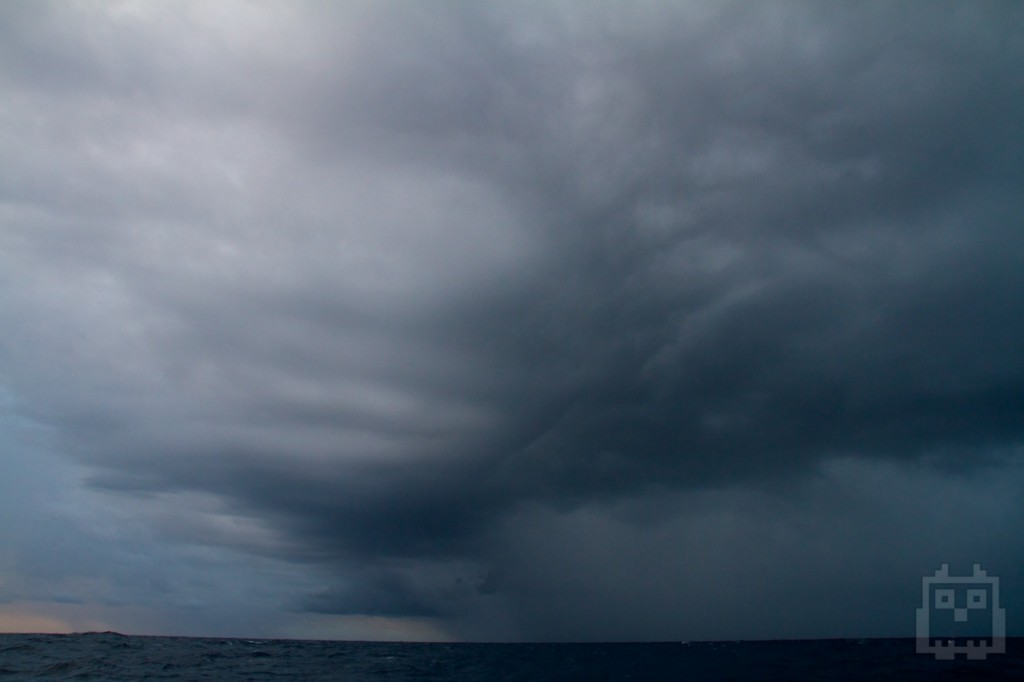
I am tired. Staying up all night doesn't get you this tired. But add the exhaustion that comes after several spikes of adrenaline, and you are getting close to the level of tired I am speaking of. I will try to be as clear and concise as possible in explaining this mishap. Maybe mishap is the wrong word, because we were quite lucky that Panache is still floating and that nobody was hurt. I guess that makes us lucky by default; however, Panache is classified as shipwrecked.
It’s hard to identify the exact genesis of any problem, because sometimes we are on a collision course without knowing it. Many actions led up to the shipwreck, but if I were to guess, I would say it all started with the knowledge of an incoming low pressure system. That kernel of knowledge set in motion a domino effect that put Panache in the condition she is in now. Don’t mistake this chain reaction theory as an admission of fault. I made those decisions. I did this. I just can’t shake the feeling that if I did just one thing differently I might have avoided this whole mess.
Panache arrived in Niue on Saturday, November 3. Vlad and I have been racing through the South Pacific to make a well-timed jump down to New Zealand sometime in mid- to late-November. A break on Niue was well-deserved. We spent the day snorkeling and catching up with our buddy boat, Eliot, who arrived the previous day. Internet was included with the Niue Yacht Club moorings, and everyone was able to catch up on correspondence, and more importantly, check the weather. It was officially cyclone season, and weather windows were now paramount for making a safe passage. Even our next passage, a short three-day 230-mile run to Vava’u, Tonga was extremely weather-sensitive. Even at rest on a mooring ball in Niue, bad weather had a tendency to push otherwise safely moored yachts towards the jagged reef, just close enough to terrify the person on anchor watch.

These guys are everywhere and have terrible eyesight. They swim right into you and then freak out and dive to the rock bottom. A little scary the first couple of times.

Sure enough, a low-pressure system was rolling through the Pacific right below Tonga and Niue, flipping the predominant wind 180 degrees and kicking up ugly swell. We were in the shadow of the low, but the weather was still going to be ugly and in full force Wednesday. Should I stay or should I go now? If I go there will be trouble, and if I stay it will be double! Elliot opted to leave on Monday morning putting them in Vava’u right as the weather might start to get hairy. I had read way too much about Niue to just skip it. I am here now and am going to see the darn island! Vlad and I agreed to stick around and see what there was to see and then leave for Vava’u afterwards. What’s the worst that could happen? Panache is sitting on a mooring ball rated for a yacht three times her size and weight. Although, once the wind-shift takes effect, the hardly protected bay of Alofi will become completely vulnerable to wind and swell, not to mention the weather pushing her towards the razor-sharp, shallow reef only a stone’s throw away. I inspected the moorings and had more than enough faith in their holding ability through 30ish knot wind and swell.
Like Elliot planned, they left for Vava’u Monday morning after trudging through the exit procedure. We hugged goodbye and made plans to meet in Vava’u. To make the most of our time on Niue, Vlad and I rented a car to take a proper tour of all Niue had to offer. The whole island is a huge, raised coral atoll with practically no beach and no rivers, giving the water an amazing clarity, 70 meters deep in some places. We spent our day exploring the sea tracks that lead to the water’s edge, poking around the caves and swimming in the warm, protected limestone nooks and arches. During our road trip we were constantly on the lookout for fruit. Coconuts were plentiful and replaced our water bottles. If we got thirsty, we would pull over for a coco break and machete a coconut into a pint of delicious coco water. Papayas were the next most plentiful food item, and by the end of the day we had 10 dinosaur-egg-sized fruits. It was a successful day (minus clogging the toilet with some new extra plush toilet paper that morning), and Vlad and I were happy we decided to stick around.



Tuesday was a wash with internet. That evening, on schedule, the weather started showing signs of an incoming front. Dinghying back to the boat was a bit strange in such colossal swell with no light to forewarn its arrival. Panache was rocking back in forth violently, and the timing of getting aboard became a task in itself. The predominant wind was now from the north, and the swell was from the northwest. This kicked Panache around just enough to make sleeping next to impossible.
In the middle of the night, I had to get up and hang out on deck for a breather. The cabin was rocking too much and there were too many noises to keep me from sleeping. A can of spray paint clinking back and forth was one of the worst offenders, due to its location in a locker right next to my head. No matter how I moved the can or packed material around it, the sound of that little mixing ball inside continued to keep me up. Impromptu ear plugs did little to dampen such a tenacious rattler.
While on deck I checked our connection to the mooring ball. The mooring itself was a big, heavy refrigerator-sized block of concrete with a nice, thick piece of nylon rope the size of my wrist to tie off to. It even had a metal thimble inside the eye-splice to reduce chafe. Taking stock of the state of our mooring job, I retreated back to the cockpit to keep an eye on things. Even with the noise and the unrelenting swell, my eyes became surprisingly heavy. The weather wasn't terrible, but it was uncomfortable, and with the larger swell, Panache was stretching the mooring line practically taut. Each time we reached the end of the line, I was jerked awake, and after a while I concluded it was more productive to sleep. As I climbed into the cabin, I was careful not to step on the bundle of papayas we relegated to the cockpit in case there were any stowaway bugs. With so many papayas there really wasn't any other place for them!
Throughout the night I would wake up periodically and take a sweep of the surroundings. Same waves, same wharf being beaten by them, nothing new of note. Vlad and I were never fully asleep, but we did fall into a limbo dream state where your brain was conscious just enough to lurch into action if need be. This must be how most animals sleep. In this state of grime and sleep deprivation I sure felt like an animal. Little did we know that during one of our partial dream states, the rocking of the boat had slowly untied the line cleating us to the mooring. Like a blind man walking towards a cliff, Panache slowly and unwittingly rocked towards the hard, coral shore just 30 meters away. I don’t know what I was dreaming about, but the most terrible sound woke me and Vlad simultaneously. It was as if a wrecking ball was ramming the bottom of the boat. Our animal sleep was broken and both of us shot up. BANG! With the force of a cannon blast, the wrecking ball struck again, jolting the whole boat like an earthquake. In a shaky voice, Vlad yelled “We’re on the reef!”
Never has my heart sunk so fast and my adrenalin risen so high in a single moment. Smashing your boat on a reef is a sure way to end any cruise quickly - if it doesnt sink your boat, it will sink your cruising ambition. Vlad couldn't stop yelling, “Wow! Wow! WOW!” with every battering the keel received from the reef. I hurried on deck and sure enough the bow of Panache was nosing into the breakers. “Turn on the engine! NOW!” I screamed. Panache was bow in, a miracle that allowed us to try to motor out of this nightmare. Let it just be a nightmare.
Vlad instinctively turned the ignition, “It doesn't work! Should we call for help!?” “What do you mean the engine doesn't work?” I responded sternly. As I hopped into the cabin to get the engine started, a wave pushed us deeper onto the reef, shoving Panache over 40 degrees and dumping us and most all our belonging onto the cabin floor. Vlad failed to turn on the engine switch on the electrical board, and with the switch now in the right position, the engine fired immediately. I jumped into the cabin, wrenched the tiller to center and threw the motor into reverse. Every wave was accompanied by the terrible noise of reef trying to shatter Panache’s fiberglass hull. My jaw was clenched together in solidarity with Panache. “Come On. COME ON! COME ON!!!” I kept screaming through my teeth. With each wave we crept further and further to a point of no return. It wasn't working. “We need to call for help!” Vlad insisted. I turned the engine off and did what every sailor fears, making a mayday call ...
Trying to steady my hand, I picked up the VHF radio; then it was time to steady my voice: “Mayday! Mayday! Mayday! This is the sailing vessel Panache. We have two persons aboard. We broke from our mooring in Alofi bay and are on the reef. Requesting assistance. I repeat; we are on the reef and requesting ...” BANG “assistance!”
I paused for a moment and got no response. It was 3 in the morning, but someone has to be on channel 16! “Should we abandon ship in the dinghy?” Vlad asked. My answer came quickly, “No, it’s safer here for the time being.” I repeated the mayday and again got no response. “Fuck it, I’m getting us off this fucking reef!” I announced and turned the engine back on.
Panache wasn't totally on her side. The reef here was steep, and if I could gun the engine with the waves I might be able to shimmy Panache free. I gave the engine every ounce of horsepower available, and slowly I could tell we were making progress with every wave that washed between us and the reef. As I turned to look aft, I saw a huge black mass heading for us. Before it struck Panache’s stern, the water under us was pulled into the black mass and the tiller twisted violently into my side with a huge SNAP, breaking like a Louisville slugger shattering from a fastball. The tiller was now hanging on by a thread to the rudder post, but that last big wave was enough to lift Panache off the reef. We were moving in reverse. We were free, but were we slowly sinking?
“Vlad, go check below to see if the boat is filling with water.” Vlad discovered a little water on in the cabin, but nothing like you see in Hollywood movies. “Shit. It’s the toilet water!” During all the commotion our plugged up toilet was dumped onto the cabin floor. This was the least of our problems at the moment. “We need to anchor, those moorings can’t be trusted.” I said, and right then I saw mooring ball number 1, the exact mooring ball we were on. The knot attaching us to our mooring, the knot I tied, had come loose, not the mooring. “This is all my fault ...” Another sinking feeling.
We limped to the mooring ball and attempted to attach ourselves but failed, only managing to tangle our dinghy (appropriately named Buoy) to the mooring line. Another clusterfuck. We were facing stern-forward into the swell, making Panache roll dangerously. We needed to fix this, but first we needed to remove all the papayas we had smashed into the world’s largest fruit salad in the cockpit. Vlad and I dug the papayaed cockpit out like dogs digging to China, not realizing we had flung half the smashed papaya into our dinghy. Whatever.
I hopped into Buoy the dinghy and started untangling the rat’s nest of knots that were preventing us from making a second approach to secure mooring. It was bad. Buoy was being smashed against Panache as Panache rolled viciously into Buoy, all while I was trying to free us from the mooring, covered in papaya. It was madness.
What felt like an eternity later, the knot was straightened out and Panache was once again drifting back towards the boiling breakwater. Our steerage was definitely having problems, but we inched once again towards mooring ball #1 and secured ourselves, this time with two lines and extra tight cleat hitches.
Exhausted, we congratulated each other for moving quickly while our heart rate leveled. It was time to call off our mayday to Niue Radio, which by this point was getting lots of attention. We disinfected the cabin floor with bleach and sat on deck to hide from the fumes while breaking down the whole four-minute event play by play.
I can’t help but think about all the things that could have been slightly different that would have produced a better outcome. If we had only left Niue with Elliot, or tied the mooring line tighter, or left an anchor watch on deck or turned the engine on a moment earlier we might be in better shape. All things considered, we were extremely lucky because everyone was ok and Panache was still floating. We stumbled onto the fine line of danger and ended up on the lucky side. The exhaustion was overwhelming, but the sleep never came. Fear of breaking free from the mooring was enough to keep us both up.
In the morning I jumped into the churning water and when the bubbles cleared, I saw the damage. Panache’s keel looked as if Jaws chewed it apart, with a superficial scar on the bow and, the bad news, a fractured rudder. Our lack of steerage and the loud SNAP the night before now made sense. I took a few pictures and hauled myself on deck. New Zealand was out of the question. I had gotten lazy, tied a shitty knot and lost New Zealand. It sounds silly, but losing New Zealand made my time in the Pacific feel like a waste. Its like hiking within visible range of a mountains peek and turning around. We would have to remove the rudder and jury rig a fix good enough to get to Tonga 310ish miles away. Before any of that, though, we would have to wait out the low pressure system that was twisting the wind and waves into two days of torture. No toilet, no sleep and all the luxuries of land teasing us only meters away. The wharf was being swallowed by the westerly swell making a landing suicide. Grudgingly we waited it out, all the while awake and overly vigilant of the lines connected to our mooring ball keeping us away from the reef. This time of paralysis gave ample opportunities for the “what if” game. I was bummed out, and my immediate plan sequenced between scuttling Panache and flying home from Niue, fixing the boat in Tonga and waiting out the cyclone season and everything in between. Whichever way, landfall in New Zealand had never felt so far away. I had failed.

Vlad was making a serious effort to steer my mind elsewhere. I usually enjoy wallowing in my self-pity, but in the end Vlad made me smile, pointing out how ridiculous the whole thing was. The papayas, the toilet water, the fact that we were shipwrecked! He made me realize the comedy in an otherwise dismal situation. His positive energy helped get me through the dejected two days.
By Thursday afternoon the swell and wind had died down to a point where we could remove the rudder. Being a small production boat was another huge win for Panache, because this job was as easy as removing two bolts. The cockpit looked naked without a rudder. We hauled the rudder into Buoy and brought it ashore the next morning.
It was a Friday when we finally stepped foot on land. Getting on the wharf was a bit of a rodeo, but we made it, 100-lb rudder in hand. A tourist named Graham who was a fiberglass guru back in New Zealand was visiting Niue and due to fly out that afternoon with the weekly jet. Keith, the head chairman for the Niue Yacht Club wrangled Graham into checking out Panache’s rudder. Within minutes of looking at the damaged rudder, Graham had a plan for fixing it! Niue Yacht Club had all the tools necessary to complete the project, and by the early afternoon the rudder was straightened and glassed over on one side. Graham worked some serious black magic. I felt pretty good about the fix thus far and couldn't thank Graham and the Niue Yacht Club enough. That afternoon we even fixed the toilet! The Niue nightmare was shaping up to be quite an adventure. A welcome transition.

Grinding down the damaged area on our rudder to pour filling compound into the fracture. We then inlayed aluminum struts perpendicular to the fracture and glassed over the whole damaged area.

As of now, I don’t know where I stand with this trip. I have been cruising for over a year now, through Southern California, Mexico, Central America, the Galapagos, and through the South Pacific. How will it end? A shipwreck isn't a bad ending, I guess, if I’m looking for a good story. Right now I am sending out feelers as to the best plan of action. We can’t stay in Niue with the cyclone season in effect, so the immediate plan is to get the boat to Vava’u, Tonga where ample cyclone-proof mooring are available. Maybe jump up to American Samoa and haul the boat out, maybe sell the boat and fly back to the States with my tail between my legs. I have options, but all of them fall short of sailing to New Zealand. Dave from S/V LightSpeed gave some good insight:
“I can't recommend sailing for NZ or anywhere with a damaged boat... it's already late in the season and let's face the fact that it can be a sketchy voyage on any boat.. I'm sure you heard about the S/V Windigo that was capsized just this week en route to NZ. Plus, tropical islands are much more interesting and likely cheaper than NZ ... Take a deep breath and take you time to sort out all your options. In hindsight this is going to be a very memorable part of your adventure, so don't make any rash decisions.”Vlad is glad for the unequivocally memorable experience he cultivated aboard Panache but is ready to move on. He will fly to New Zealand and then back to the States for Thanksgiving once he arrives in Tonga. I don’t blame him; I am a little burnt out myself. The fiberglass has hardened. I have more to say, but Vlad and I need to glass the other side of our rudder. We need to get Panache moving again.































